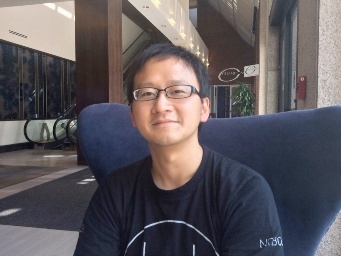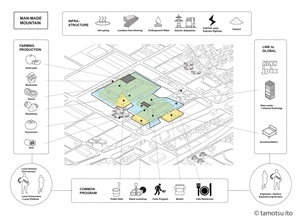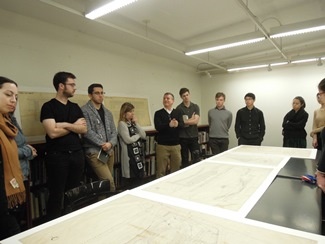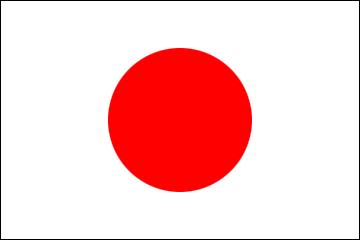Interview : Mr.Tamotsu Ito – Harvard Graduate School of Design
December 8, 2016
1. Graduate School Project
- My final thesis project for graduate school was called “A Man-Made Mountain” and was designed to replace an abandoned shopping mall in the Motosu City suburb of Gifu City, where I am from. My purpose is to contribute to my hometown through architecture by converting the shopping mall, which was closed after only 9 years, into a feature of the town containing both aspects of production and consumption. My design is to turn it into a complex including a data center with the fastest optical cable in Japan. In the same building, I created a greenhouse to utilize the heat from the data center in order to grow local products like strawberries and persimmon. I also created restaurant and market that would allow people to consume local products from the greenhouse and the surrounding area. I tried to make my idea as feasible as possible – we have a rich underground water supply from the Nomi Plains that can cool down the servers, and I designed the building using local materials and methods in which local carpenters can participate, so that we can contribute to local businesses.
- The title of my project, “A Man-Made Mountain”, comes from concept of the “Satoyama” (community forestry) ecosystem. Similar to the function of the “Satoyama,” this project would create a better relationship between the complex and local society. Sometimes architecture is valued solely for its special shape and is far from such practical features as function, constructability or comfortability, even if the design itself is made under careful consideration. It often happens that university programs don’t teach practicality to be as important element of design as it really is, and therefore design discourse made by academia is sometimes so much different from real design practice. On the other hand, it is important that designs address philosophical and social questions so that it can provide a consistent plan from details such as function, seismic capacity and security to urban design. I wanted to show that feasible design with a consistent concept has the capability to raise questions about complicated social problems if an architect stays consistently involved in everything from the details to the whole picture. I pursued pragmatism and precise design more than other students, but as a result, my project has been valued by professors and others because the “design” in academia, including philosophy, shape, energy plan, function, structure and constructability can influence a whole society and I showed how an architect can tackle difficult problems in local suburb cities like my hometown, which I wanted to work on from a global perspective.
2. Kenzo Tange Archive at Harvard Graduate School of Design (GSD)
- I participated in the team of organizing Kenzo Tange archive in Harvard GSD from the beginning of 2015. He is one of the most famous architects in Japan, and is known for numerous masterpieces of public projects such as the Hiroshima Peace Memorial Park and the Yoyogi National Gymnasium. The archive of his drawings has been donated to Harvard GSD but it needed to be organized to make a database of huge numbers of drawings to be open to the public. Drawings of the Yoyogi National Gymnasium were particularly impressive because of the large number, the precisely handwritten 3D structures, and the tense revisions at the stage of construction. It is an honor as a Japanese architect to be able to be involved in this project. I did my best so that the archive will be seen by as many people in the world as possible.
3. Why Study in America
- Normally, Students studying at faculties of Engineering / Science students in Japan go to graduate school right after college. However, I felt that education in design school at that time was very far from the reality of working in the architectural industry. Even though I learned how to propose unique ideas in graduate school without limitations, in the real world there are various conditions such as cost and regulations. I thought it would be difficult to achieve my goal which is to make feasible and consistent architecture while integrating/accommodating all conditions positively, rather than regarding them as “limitations”. I decided to go to an architecture office to learn the practical aspects of making architecture, and then go to a graduate school. While I worked for the office, I was in charge of several projects, such as a private home and a public project, and I gained valuable experience. At the same time, I got first-class and managing architect licenses. After working for 5 years, I quit my job and devoted a year to studying in order to prepare for graduate school while occasionally working on the side for individual projects.
- I wanted to come to the US because there are 1-2 year courses for people with architectural working experience and it’s common to work before going to graduate school, so I thought I would be able to study with people with similar experience. Also, from my work experience in Japan, I felt that there were some problems in the architecture industry in Japan. I thought that by going abroad I would be able to find out how to tackle the problems. At that time, I had never lived abroad or rarely used English at work. There are few Japanese students who want to study architecture in the US, which made it difficult to find information. I was determined, so I prepared hard for the TOEFL tests and made a portfolio. I chose Harvard because it offers most the diverse majors in the US and has students from diverse backgrounds. Also, Harvard itself has an interdisciplinary culture, which made me hope that I would get a multifaceted view of architecture. In reality, my graduate project managed to use all of my experience from my undergrad days and from work and graduate school. I felt like I really was able to achieve my goal of putting my knowledge from Japan and Harvard into use in the same direction.
4. Purpose and Dream for the Future
- Starting in October I am working at an architecture office in New York City to learn real design work in the US. I would like to contribute to a better society through design, so I tried to learn frameworks of NPOs and NGOs while getting my masters, but as a result I got to know that small Japanese business organizations have more difficulty with funding compared to the US, so it’s difficult to contribute enough to society through NPO or NGO activities in Japan so far. I would like to continue to think about how to make NPOs and NGOs (or other frameworks such as social entrepreneurs) more active and effective to achieve the great purpose of contributing to society. I may want to teach and research in labs at a university in Japan, because one is able to do research regardless of making a profit, which I think is unique and a good side of Japanese architectural education, compared to other countries. I am still not sure what I would really like to do but I would like to continue to work as an architect to deepen my understanding.
5. Advice for Students Who Wish to Go Abroad
- When I applied for admission to the US graduate schools, I could only write for my future plan about vague ideas of society’s problems. It was lucky for me to be able to pass with that essay. However, it may be because these problems are more intense than others. Even if you still don’t have a precise plan in your future but you think you are not satisfied with who you are or want to make society better through positive change, going abroad is a great opportunity. Don’t worry about how your career or your personal values will be influenced and please work hard to make it happen. (Probably except business schools) I feel that there are few Japanese people that study abroad without belonging to a big company, a public institution, or the government. However, in the US it’s very common to study without such backgrounds. I don’t say which is good/bad, but in terms of envisioning diversity within Japanese society, I think the Japanese should also value people with backgrounds like me more and there should be a support system for people who study abroad by themselves as an individual or as a small entrepreneur. They often have some different experiences from others – that unique experience and studying abroad make that person’s life more unique and interesting and can make Japanese society more diverse and interesting. I hope that this can impact the Japanese system.

【Career of Mr. Tamotsu Ito 】
| 2008 | University of Tokyo - Department of Architecture (Bachelor of Engineering) |
| 2008-13 | Architecture offices in Japan |
| Sep 2014-May 2016 | Harvard Graduate School of Design (Master in ArchitectureII) |
| Oct 2016 | OLI Architecture PLLC New York Office |
| 2017- | Columbia University Graduate School of Architecture, Planning and Preservation Adjunct Assistant Professor |



